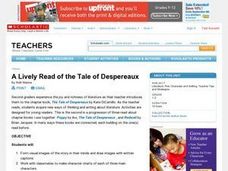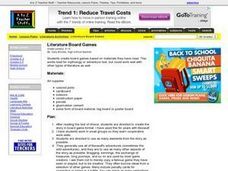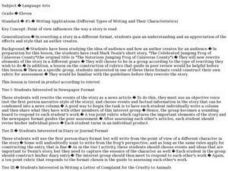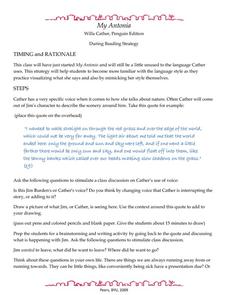Curated OER
Exploring the Mystery Genre
Students determine the story elements of typical mystery stories including characters and plot structure. They look at vocabulary that is common to mystery stories before reading and responding to mystery chapter books. Working in guided...
Curated OER
Lively Read of the Tale of Despereaux
Students create a character map of the main characters in The Tale of Despereaux. After reading the text, students create a character chart based on information they gleaned from the story. They use this information to write a letter...
Curated OER
Write, Right
This resource provides the beginning ideas for a lesson on writing a narrative. Learners watch a video, identify story elements, including plot and setting, and then write their own stories. If augmented, this lesson could provide a...
Curated OER
A Fine Feathered Flock
Students role play different situations. In this respect lesson, students read Mr. Lincoln's Way, identify the story elements and answer comprehension questions. Students discuss how they can always treat others with respect and role...
Hawaiʻi State Department of Education
Comparing Themes
The tale of "Lon Po Po" is a Chinese story, very similar to the European tale of "Little Red Riding Hood." Learners make cross cultural comparisons between the two tales, focusing on themes common to both. They review story elements such...
Curated OER
Book Trailers/Sneak Peeks
Looking for a motivating and creative technology lesson? Then this lesson is for you! After viewing a movie trailer, middle-schoolers follow that design to create a video preview of a book's story elements. They also create a storyboard...
Curated OER
Mayan Myths/Folktales
Middle schoolers work on summarizing a story, and they determine if it is a legend, a myth, or a fable. Working in groups to read and summarize stories, they then list evidence whether the tale is a myth, fable, or...
Curated OER
A Togolese Tale: The Big Fire
Students read a Tonolese folktale and outline the elements of the story. In groups, they discuss the various morals presented in the story and if they are unique to the Tonolese culture. To end the instructional activity, they identify...
Curated OER
Literature Board Games
Students create board games out of pieces of literature they have read. They work together to develop rules and elements of the game. They are to use as many elements of the story as possible. They play each game as a class.
Curated OER
Big Pumpkin
Learners read a story and retell it through role playing. They will read Big Pumpkin, identify the main ideas and important characters, retell the story through dramatic play, and identify their favorite character.
Curated OER
Loving Literature
First graders, after having "Are You My Mother?" by P.D. Eastman read to them, participate in group discussions or independentally work to analyze a spreadsheet to identify essential elements in the story and graph their data. In...
Curated OER
Writing Applications: Different Types of Writing and Their Characteristics
Twelfth graders rewrite a story in a different format to understand the effects of the author's style. In this writing style instructional activity, 12th graders read Mark Twain's "The Celebrated Jumping Frog of Calaveras County" and...
Curated OER
Parts of a Story
Learners read a short fiction book and demostrate comprehension by identifying the main characters, setting, conflict, theme, and summarizing the main points. They organize the information in Inspiration and create a powerpoint to show...
Curated OER
A Study of China with Lon Po Po, a Chinese Little Red-riding Hood
Sixth graders study and identify the elements of a story such as. setting, character, plot, and theme, using two versions of the folktale Little Red-Riding Hood. They use the Internet to locate more information on the author Ed Young.
Curated OER
The Allegorical Jonathan Livingston Seagull
Students write and discuss the definition of an allegory. They read the story, Jonathan Livingston Seagull, and analyze the style and allegorical elements within the story.
Curated OER
The Sorcerer's Apprentice
Third graders listen to "The Sorcerer's Apprentice". Using the music, they identify the high and low parts in the orchestal composition. They compare the elements of a story to the piece of music and respond to the music and state how...
Curated OER
Symbols of a Life
Students identify the narrative elements in a work of art and write their own narrative. In this narrative and symbolism lesson, students interpret narratives depicted in the given works of art and write a biographical narrative about a...
Curated OER
Storyboard for Persuasive Text
Middle schoolers demonstrate their knowledge of the main elements of a story by creating a storyboard. In this persuasive writing instructional activity students create storyboards that are intended to persuade a director to make a...
US Institute of Peace
Observing Conflict
Identifying conflict is important, but how do you handle conflict when it comes? Learners use a plot mountain to graph two role-play scenarios about interpersonal conflicts.
Curated OER
Keep the Lights Burning, Abbie -The Story
Learners explore lighthouses in literature. In this reading activity, students read Keep the Lights Burning, Annie as well as Birdie's Lighthouse. Learners participate in pair/share activities regarding plot and literary devices. Student...
Bantam Books
The Tempest: Think-Aloud Annotation
It can be difficult to refer back to a text when analyzing it, so annotation is a great tool for kids to track what they are reading. A thorough and well-organized lesson plan guides learners through the process of annotating William...
Curated OER
My Antonia: During Reading Strategy
Home in on the quote on this page to explore setting, the author's and character's voices, and plot in Willa Cather's My Antonia. Pupils draw a picture of what is described in the quote, discuss the content, and make connections to their...
EngageNY
Grade 9 ELA Module 2: Unit 1, Lesson 9
Continue analyzing literature using textual evidence with a lesson on "I Felt A Funeral, in my Brain" by Emily Dickinson. Ninth graders bring their annotation skills and knowledge of figurative language from the previous eight sessions...
K20 LEARN
Analyzing Literary Figures: Analyzing Literature
The author study gets an update in a research project designed for high schoolers. Scholars search for information about literary figures that connects them to their times, their works, their themes, and other writers. Researchers also...
Other popular searches
- Story Elements
- Short Story Elements
- Fable Story Elements
- Teaching Story Elements
- Identify Story Elements
- Story Elements Chart
- Analyze Text Story Elements
- Story Elements Character
- Story Elements Collage
- Identifying Story Elements
- Short Story Elements Quiz
- Story Elements Map























